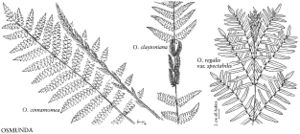Osmundaceae
Plants terrestrial, herbaceous, frequently in clumps. Stems creeping, beset with old petiole bases and black fibrous roots; scales absent; older stems seldom persisting. Leaves monomorphic or dimorphic. Blades 1–2-pinnate (2-pinnatifid); rachises grooved. Pinnae monomorphic or dimorphic. Indument of reddish to light brown hairs. Veins dichotomous, running to margins. Sori absent; sporangia born on slightly modified fertile segments of blades also possessing fully expanded pinnae, or sporangia covering blades lacking green expanded pinnae, clustered in marginal zones, indusia lacking. Spores green, all alike. Gametophytes green, aboveground, obcordate to elongate.
Distribution
Nearly worldwide, temperate and tropical regions.
Discussion
Osmundaceae are considered intermediate in several respects between eusporangiate and leptosporangiate ferns. In the absence of sori, simultaneous maturation of spores, and development of sporangia from several initial cells, they are much like eusporangiate ferns. Their large prothalli with projecting antheridia are similar to those of leptosporangiate ferns.
Genera 3, species 16–36 (1 genus with 3 species and 1 hybrid in the flora).
